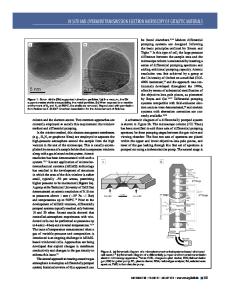Application of in situ transmission electron microscopy for tribological investigations of magnetron sputter assisted pu
- PDF / 2,265,777 Bytes
- 9 Pages / 612 x 792 pts (letter) Page_size
- 52 Downloads / 332 Views
Yttria-stabilized zirconia (YSZ)-Au composite coatings have great potential as solid film lubricants for aerospace applications over a wide range of environmental conditions. They were grown on steel disks or silicon wafers by pulsed laser ablation of YSZ and simultaneous magnetron sputtering of a Au target. Such a combination of ceramics with soft metals improved the toughness of the composite coating and increased its ability to lubricate at high temperature. Information on the time-dependent response of these microstructures to changes in temperature is essential to tribological investigations of high temperature performance. In situ transmission electron microscopy was used to directly measure the dynamic change of YSZ-Au coating structure at elevated temperatures. High-resolution electron microscopy and electron diffraction showed that amorphous YSZ-5 at.% Au coatings proceeded to crystallize under the irradiation of electron beams. Time varying x-ray energy dispersive spectra measured a loss of oxygen in the sample during about 10 min of irradiation with subsequent slight oxygen recovery. This behavior was related to the activation of oxygen diffusion under electron irradiation. X-ray diffraction patterns from vacuum annealed samples verified crystallization of the coatings at 500 °C. Real-time growth of Au nanograins in the sample was observed as the temperature was increased to 500 °C in a TEM specimen holder that could be heated. The grain growth process was recorded using a charge-coupled device camera installed on the transmission electron microscope. The crystallization and growth of zirconia and Au nanograins resulted in low friction during tribological tests. The nucleation of Au islands on heated ball-on-flat specimens was responsible for lowering friction.
I. INTRODUCTION
Yttria-stabilized zirconia (YSZ)-Au composite coatings have great potential as low-friction, wear-resistant coatings for aerospace applications over a wide range of environmental conditions.1–3 Low wear rates and friction coefficients are highly desirable for increasing the lifetime and performance of aerospace components. YSZ was selected as a matrix because it has a unique combination of mechanical properties: hardness of 11–15 GPa, one of the highest fracture toughness values of ceramic materials, elastic modulus and thermal expansion coefficient matching that of steels, and excellent thermal
a)
Address all correspondence to this author. e-mail: [email protected] DOI: 10.1557/JMR.2005.0232 1860
http://journals.cambridge.org
J. Mater. Res., Vol. 20, No. 7, Jul 2005 Downloaded: 12 Mar 2015
stability.4,5 The tribological properties of YSZ ceramics have been widely studied in relationship to the test environment, contact load, sliding speed, and temperature.6–11 The friction coefficient of YSZ ceramics was found to increase at elevated temperatures.8,9 Wear rates are proposed to be inversely proportional to the fracture toughness to the forth power.12 Metallic Au is soft and ductile, and can provide low friction, so it
Data Loading...











